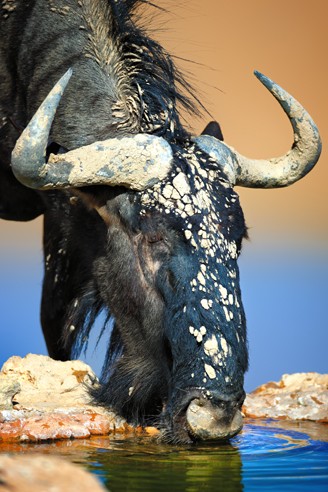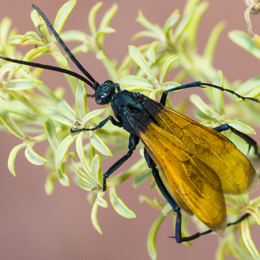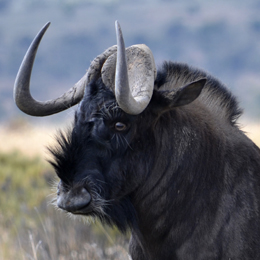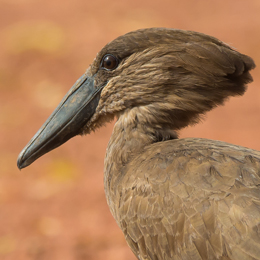Blue Wildebeest
William John Burchell, a naturalist from England, first described the Blue Wildebeest in 1823 and also coined its scientific name ‘Connochaetes taurinus’. The generic name, Connochaetes has been derived from two Greek words ‘konnos’ and ‘khaite’, referring to the characteristic beard and mane of this animal. However, the origin of its specific name ‘taurinus’ can be traced back to the word ‘tauros’ which translates into bull or bullock in Greek.

Blue wildebeest of Africa
?
Image credits: Gary Stone/Shutterstock
The Blue Wildebeest is also commonly known as the Common Wildebeest, Brindled Gnu and White-bearded wildebeest. The mammal has a broad shoulder, muscular forequarters and a distinctively robust muzzle. The coat of this antelope is usually gray with a silvery-blue sheen which earned it the name of Blue Wildebeest. Adult males of this species generally appear darker than females.
Among the two existing species of wildebeests, the Blue Wildebeest is the largest, both in size and weight. The average shoulder height ranges from 115 to 145 cm (45 – 57 inches) while the typical head-body length is 170 – 240 cm (67 – 94 inches). With a maximum weight of 260 kg (570 lb), the females are lighter than the males that can weigh up to 290 kg (640 lb). The features and physical markings among both sexes are bilaterally symmetrical. One of the prominent characteristic features of this White-bearded Wildebeest is their long black tail that has an average length of 60 -100 cm (24 – 39 inches).
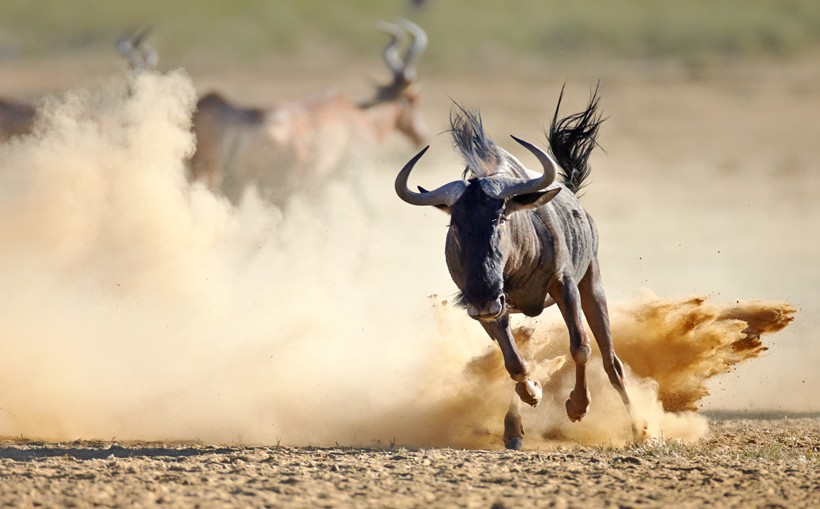
Blue wildebeest running on dusty plains, Kalahari desert, South Africa
?
Image credits: Mari Swanepoel/Shutterstock
Similar to the Black Wildebeest, the Blue Wildebeest is very agile and can attain a running speed of almost 80 km/hr (50 mph). It has great strength and uses its large horns to defend itself from predators.
The average lifespan of this large wildebeest is 20 years. However, one individual of Blue Wildebeest has lived up to the age of 24 years in captivity.
Subspecies and Geographical distribution
Blue Wildebeest has five subspecies, each inhabiting different regions of Africa:- C. t. albojubatus: Commonly known as the Eastern White-bearded Wildebeest, this species is mainly found south of the equator line in the Gregory Rift Valley. Its range of habitat includes northern Tanzania and central Kenya.
- C. t. cooksoni: This subspecies of Blue Wildebeest inhabits the Luangwa Valley of Zambia. Occasionally, this animal may also wander off around the plateau of central Malawi.
- C. t. johnstoni: Also known as the Nyassaland Wildebeest. The habitat range for this subspecies extends from Mozambique to Tanzania. A small population of this subspecies occurred also in Malawi earlier but has gone extinct from that region.
- C. t. mearnsi: Popularly known as the Western White-bearded Wildebeest, the population of this subspecies occurs in regions ranging from northern Tanzania to southern Kenya. Among all the subspecies, C. t. mearnsi is the smallest in size and possesses the shortest horns. This subspecies also forms the enormous herds of the famous Serengeti-Masai Mara.
- C. t. taurinus: C. t. taurinus or Common Wildebeest is mainly found in the southern part of the African continent. Its primary range includes Namibia, South Africa, Mozambique, south-western Zambia and southern Angola.
Moreover, Blue Wildebeest is also a relative species of the Black Wildebeest with which it shares its genus, Connochaetes. Earlier the Blue Wildebeest was classified in a separate genus Gorgon. However, recent DNA studies of both species proved that these two are phylogenetically related. Since then, both Blue and Black Wildebeest have been classified under the same genus.
Hybrids
When the Blue and Black Wildebeest are put together, they hybridize with each other resulting in fertile offspring. This hybrid offspring may grow up to be larger than either of their parents, but may also have congenital abnormalities in their skull, teeth and horns. Some hybrids of Blue and Black Wildebeest even show highly deformed auditory bullae and in some individuals, the bones of radius and ulna have been found to be joined together.
Anatomy and Characteristics
The body of the Blue Wildebeest appears a little disproportionate with the front end being heavily built and the hindquarters being slender with spindly legs. The shoulders are broad and the head is rectangular-shaped. The muzzle is wide and robust matching with the muscular forequarters.
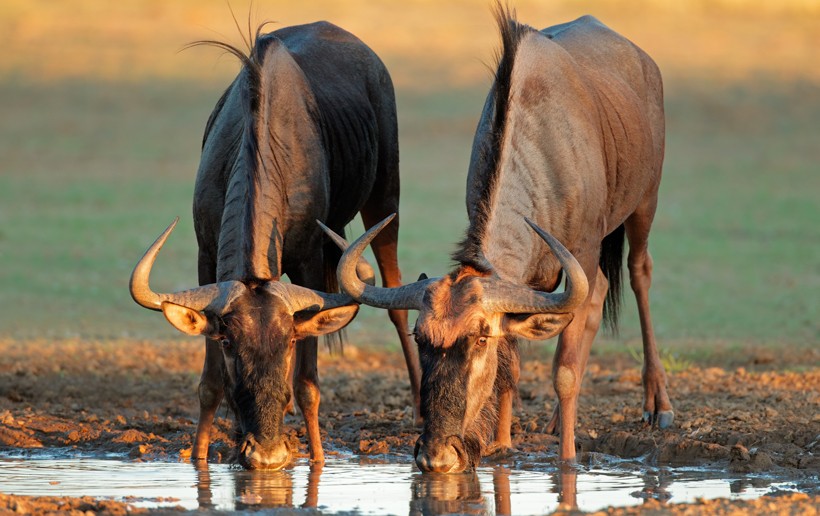
Blue wildebeests drinking water, Kalahari desert, South Africa
?
Image credits: EcoPrint/Shutterstock
The color of their coat ranges from light gray to bluish-gray to even grayish-brown that often reflects a bluish sheen under the sun. Vertical stripes of a dark-brown color can be seen running down the shoulder in between the neck area and over the ribcage. The manes are black in color and characteristically long, stiff and thick. The long beard down their chin and neck may either be darker or paler depending on the various subspecies of the Blue Wildebeest. Both the sexes of this species have scent glands in their forefeet that secrete special oil during the mating season. These scent glands among the males are considerably larger than that of the females.
Both males and females of Blue Wildebeest have a pair of curving horns that extend outward on the sides before curving upward and inward. The length of these curving horns among the males is 83 cm (33 inches) while in the case of females, this length can vary from 30 to 40 cm (12 – 16 inches). As the animal becomes older, the base of the horns also becomes knobbier.
Diseases
The Blue Wildebeest can easily get affected by a number of diseases like the foot and mouth disease, sarcoptic mange, anthrax and the hoof gangrene disease. In fact, it was the Blue Wildebeest from which the herpesvirus was isolated for the first time in 1960 by a veterinary scientist named Walter Plowright. With the help of various studies, it has been estimated that about 47 % of deaths among Blue Wildebeest are caused by various diseases, 37 % by predation and the remaining 16 % by different kinds of accidents. Besides this, the species of Blue Wildebeest also serves as a host for several parasites.
Habitat
The geographical range of Blue Wildebeest ranges from Eastern to Southern Africa with their southern range being bordered by the famous South African Orange River. The typical habitats of this wildebeest mostly include open woodlands, floodplains and dense bush. They have a special preference for the Acacia savannahs and the areas with moderate levels of soil moisture where grasses can grow at a faster rate.
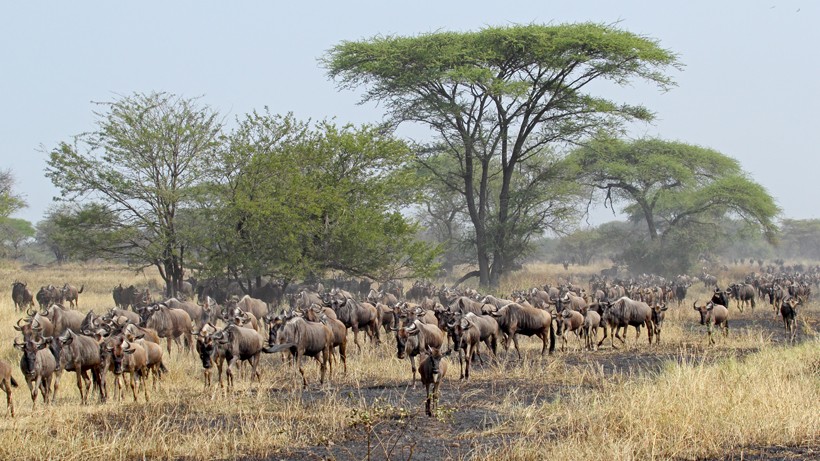
Herd of blue wildebeests
?
Image credits: MattiaATH/Shutterstock
Diet and Predation
Diet
Being a herbivore, the primary diet of Blue Wildebeest involves short grasses that grow profusely within its habitat of savannah grasslands and plains. The broad mouth allows this animal to eat huge amounts of grass within a short period. However, during the dry season, when grasses become scarce, these animals begin to include foliages of trees and shrubs in their diet. Herds of Blue Wildebeest are frequently seen cohabitating with the plains zebras because of the latter’s dietary habit of eating the upper and less nutritive grass canopy resulting in exposing the lower and greener materials below for the wildebeests.
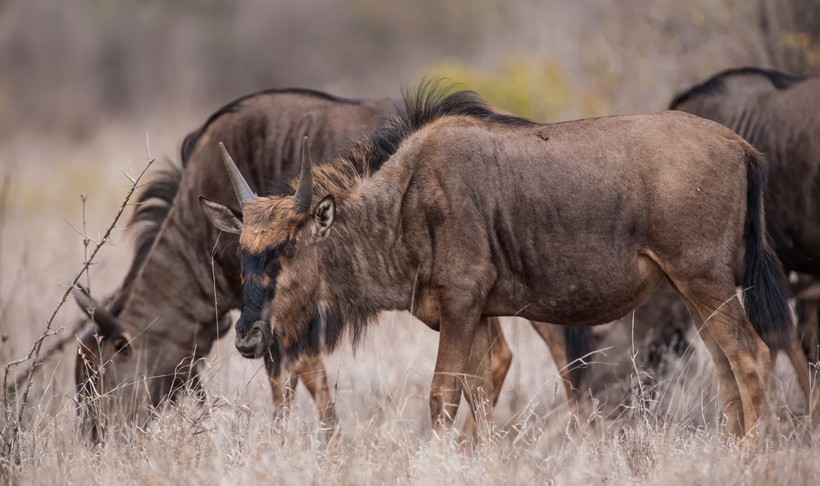
Blue wildebeests feeding in Botswana
?
Image credits: Travel Stock/Shutterstock
The Blue Wildebeest requires water regularly and therefore drinks water every day for at least two times. As a consequence, they prefer to inhabit the moist grasslands where water sources are abundant. On the other hand, despite the regular requirement of water, the Blue Wildebeest has the capacity to live in dry areas of the Kalahari Desert by including large amounts of water containing roots and tubers in its diet.
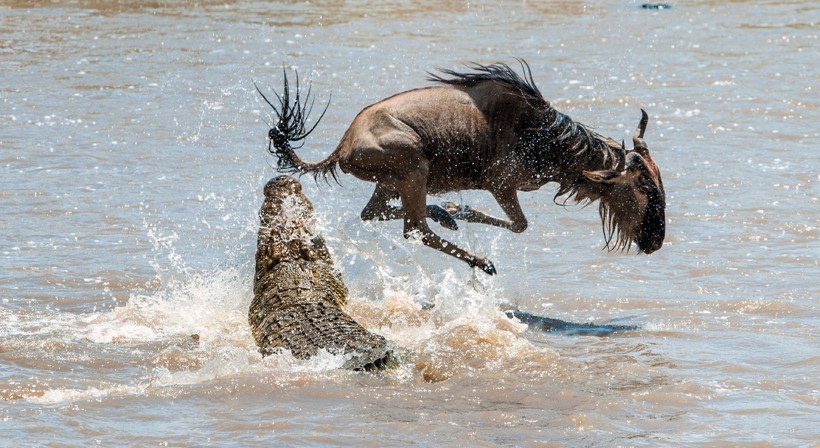
Blue wildebeest attacked while crossing the river Mara
?
Image credits: Sergey Uryadnikov/Shutterstock
Predation
Large carnivores like Lions, Leopards, Hyenas and African Wild Dogs frequently predate on Blue Wildebeests. Members of the larger herds of this antelope are predated more often than members of the smaller and more vigilant herds. When Blue Wildebeests spot an approaching predator, they bunch together, stamp on the ground and utter loud alarm calls to alert all members of their herd.
Reproduction and Life Cycle
Male Blue Wildebeests attain sexual maturity within 24 months while females become capable of breeding at about sixteen months of age, depending on their nourishment. The mating season of these animals begins as the African rainy season comes to an end and lasts for only three weeks. This suggests that both the sexes are at the prime of their health during the mating season as they get the chance to feed on the new grass growth that is highly nutritious. This results in a high conception rate which is about 95 %. Moreover, the lunar cycle has been found to influence the breeding cycle of Blue Wildebeest as the rut among males generally begins during full moon nights. During this time, the testosterone level among the males reaches a very high level which intensifies their territorial behavior and call rates. This increased sexual excitement among the males also stimulates the female Blue Wildebeests to become receptive.
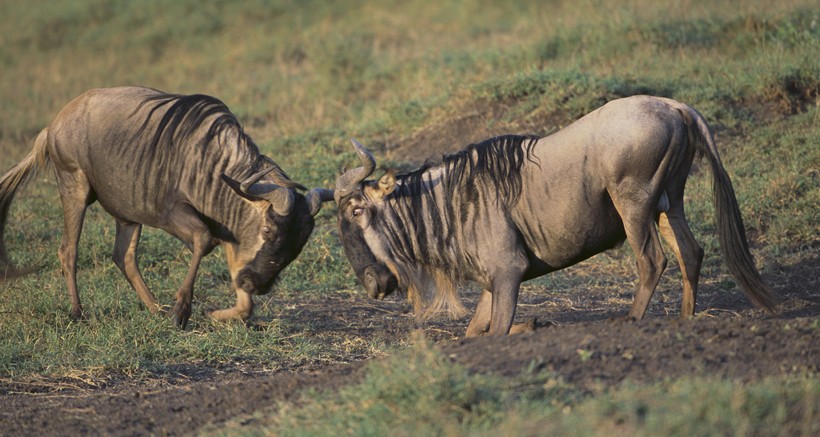
Blue wildebeests in rut competing
?
Image credits: Volt Collection/Shutterstock
When the males are in rut, they compete for females by exhibiting rivalry. When two Wildebeest-males clash with each other they exchange horn thrust and face up each other by bending their knees. In addition to this, the males also display their sexual behavior by bellowing, snorting and digging their curved horn into the soil repeatedly. After establishing dominance, the male Blue Wildebeest engages itself in luring the estrous females into his territory. Copulation takes place shortly after displaying typical courtship behavior that involves low stretches and urination. During the mating season, a female Blue Wildebeest visits a number of male territories and copulates with several males.
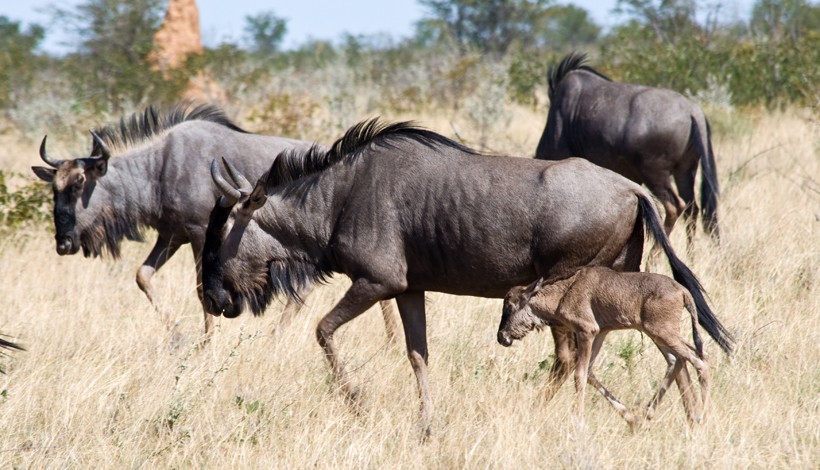
Blue wildebeest calf in Etosha National Park, Namibia
?
Image credits: erichon/Shutterstock
The gestation period of the female Blue Wildebeest lasts for about 8 to 8.5 months after which a single calf is born. The females give birth during the day, especially around noon, which provides the newborn enough time to stand on its feet and become steady before the night falls and most predators become active. As newborns, the calves weigh approximately 19 kg (42 lb) and are able to stand on their feet within about 6 minutes of birth. In order to escape from predation, the calves remain in close proximity to their mother. They are born with a tawny brown colored coat and the adult coloration of bluish-gray begins to set in after two months. Both mother and offspring depend on their sense of smell for recognition. The average age of weaning is eight months after which most of the male calves leave their mother’s side in order to form loose-knit juvenile herds with other yearlings.
However, some of these calves may even keep on suckling until the start of the next calving season. Bachelor herds are formed by the young males below the age of four.
Behavior, Communication and Intelligence
The Blue Wildebeest remains most active during early morning and late afternoon and rests during the hottest period of the day. A study on Blue Wildebeests inhabiting the Serengeti National Park revealed that these animals spend more than half of their life by resting, 33 % for grazing, 12 % for moving around while interaction with other individuals is very limited. Variations in this behavior were observed depending on age, season and sex group of these antelopes.
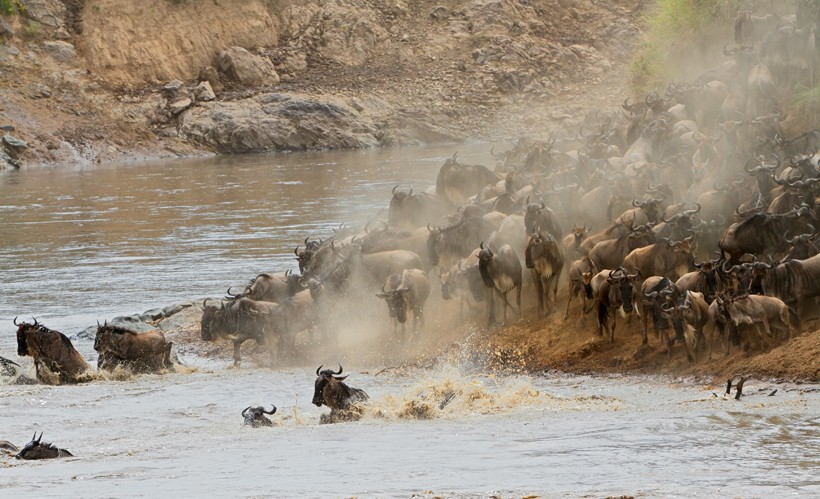
Migratory blue wildebeest, crossing the Mara river, Masai Mara National Reserve, Kenya
?
Image credits: EcoPrint/Shutterstock
The species of Blue Wildebeest displays both gregarious and territorial nature. These animals form massive herds and undertake long migration during the dry and rainy seasons in search for favorable grass and water. In fact, their need to follow the seasonal grazing and find adequate water supplies results in the formation of the largest migratory herd of antelopes both in Kenya and Tanzania. These huge herds of Blue Wildebeest also form a part of the largest aggregation of huge land mammals in Africa. However, depending on the habitat, some populations of Blue Wildebeest tend to move around in the same area all throughout the year.
Blue wildebeests live in close proximity to each other and move around their habitat in loose aggregation. Young male calves form juvenile groups which can be easily distinguished from the bachelor herds from their lower amount of activities and spacing. Bulls tend to become territorial at about 4 to 5 years of age which is marked by their increasing noisy behavior and activeness. Although being territorial, the bulls of Blue Wildebeest can remain close to other bulls; around 270 bulls of this species have been found to share an area of one square kilometer. During the night, Blue Wildebeests take rest in groups with the number of individuals ranging from a few to over thousands and maintaining a minimum distance of about 1 – 2 meter (3.3 – 6.6 ft) from each other. However, mothers and calves maintain a close contact almost all the time.
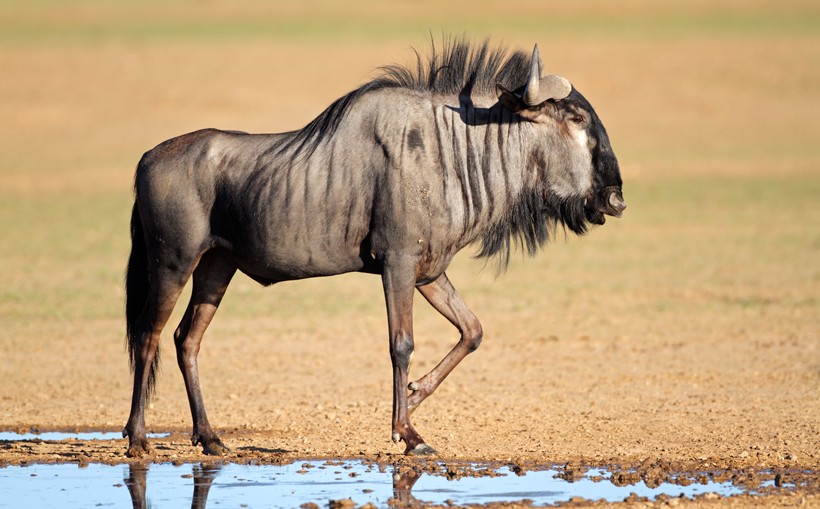
Blue wildebeest at a waterhole, Kalahari desert, South Africa
?
Image credits: EcoPrint/Shutterstock
Most of the territories established by the bulls are temporary as only a few males have been seen holding permanent territories. The boundaries of these temporary territories are usually marked by heaps of dung along with the secretions produced by their scent glands. Besides the physical markings, the bulls also advertise their territories by displaying certain behaviors like standing tall in an erect posture, frequent defecation, profuse ground pawing, rolling and bellowing out the sound of “ga-noo” repeatedly. When the bulls compete for territory, they grunt loudly and paw the ground while thrusting their horns forward.
Population and Conservation Status
Blue Wildebeests are found throughout Eastern and Southern Africa that includes parts of Kenya, Tanzania, Zambia, Zimbabwe, Mozambique, Botswana, Swaziland, Angola and South Africa. This animal has become extinct in Malawi while on the other side, a successful reintroduction of this species has been carried out in Namibia.
Besides their natural predators and outbreaks of disease, the population of Blue Wildebeest gets affected by a number of human-related factors like large-scale deforestation, expansion of human settlements and illegal hunting. However, the greatest threat to the population of Blue Wildebeest are human activities that prevent these antelopes to follow their traditional migratory routes that they undertake to survive dry seasons. These activities include erecting fences, eliminating natural water sources by irrigation practices and turning the open woodlands and savannahs into agricultural land. A study made on the various factors influencing the population of Blue Wildebeest in Maasai Mara ecosystem found that the population of this animal has suffered a drastic decline from about 119,000 individuals to 22,000 within a span of 22 years. The primary cause for this declination was the rapid expansion of agricultural land that resulted in the loss of prominent habitats of this animal.
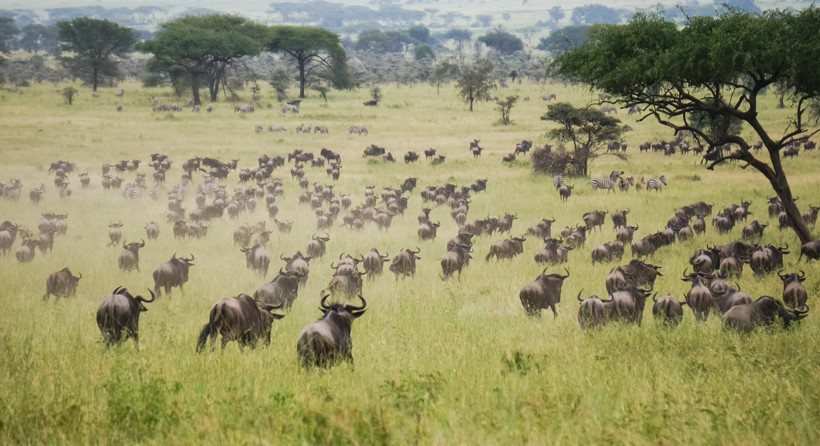
Blue wildebeest migration herd, African savannah
?
Image credits: wxin/Shutterstock
At present, the total population of Blue Wildebeest in Africa has been estimated to be 1,550,000 with their number rapidly increasing in the Serengeti National Park in Tanzania. Moreover, this species has also been introduced successfully in Namibia over various reserves, private game farms and conservancy areas. As a result, the International Union for Conservation of Nature (IUCN) has placed this species of wildebeest in the category of “Least Concern”.
Evolutionary History
The species of wildebeest evolved about 2.5 million years ago. However, it was not until the mid or late Pleistocene that the species of Black Wildebeest diverged from Blue Wildebeest and went on to become a distinct species about one million years ago. Fossil evidence of the ancestors of this animal suggests that they were very common in the past. Besides Eastern Africa, fossilized ancestors of Blue Wildebeest have also been found in Cornelia, Elandsfontein and Florisbad.
Funfacts
- Despite the ox’s head, horse’s tail and buffalo’s horns, the Blue Wildebeest is actually an antelope.
- Out of the two species of wildebeests, the Blue Wildebeest is the largest in terms of size and weight.
- During the mating season, the bulls of Blue Wildebeest become very noisy and keep on bellowing repeatedly in an attempt to attract the females.
- The Blue Wildebeest seasonally migrate in huge herds consisting over thousands of individuals.
- The Blue Wildebeests are extremely agile animals that can run at a speed of 80 km/h (50 mph).
